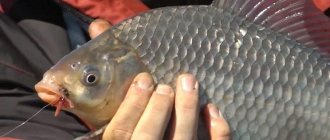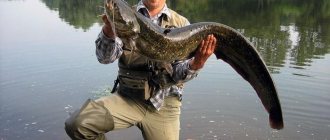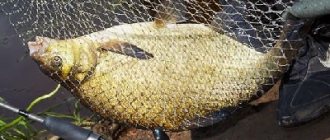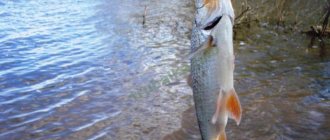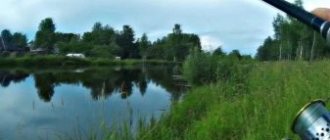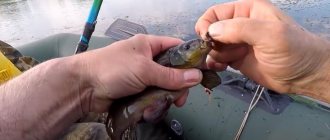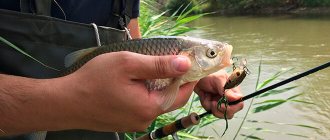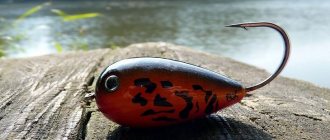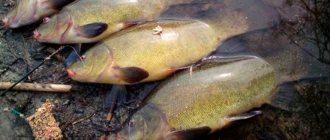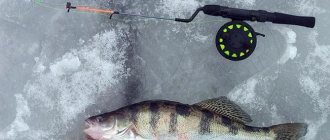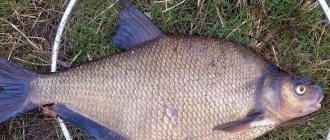To catch sabrefish on a feeder, you need to deviate somewhat from the usual tactics of feeding and bottom fishing. This fish moves in the water column; it does not feed from the bottom, as it is simply not adapted for this. The feeder is positioned as a bottom tackle, however, with the right approach, you can also catch riding fish with this tackle - sabrefish, shemai, bleak. Let's look at how to catch sabrefish on a feeder purposefully, what equipment and fishing techniques to use.
Catching sabrefish on a feeder
Chekhon is a pelagic fish, like shellfish and bleak. It feeds in the water column in schools, grabbing everything it can catch in flight, including small fry. Therefore, many fishing methods work for this fish, including tyrants and small spinning baits. There are no problems with the bite and its implementation when catching saberfish - the silver saber always grabs greedily and boldly. In water it can reach breakneck speed. Its entire body constitution shows this - a keel on the belly, a slender body, long fins similar to wings.
The main difficulty when catching sabrefish is choosing a place and finding fish. If you managed to find it and choose the right fishing horizon, there will be a catch. Chekhon is not picky about the bait and the delicacy of the equipment - the main thing is to find a feeding flock. This is the main difficulty of fishing for it.
Chekhon lives in large and medium-sized rivers and in their reservoirs. Often it stands far from the shore, located in the water column with great depth. Therefore, finding it in wide expanses of water can be difficult. However, the favorite places of saberfish are constant, and local fishermen know where to catch this fish. For fishing with a feeder rod, we are primarily interested in those rivers where sabrefish can be reached from the shore. These are either known points of its permanent habitat, or rivers in which it rises to spawn in the spring.
It is the fishing of sabrefish in the spring that is considered the best period for such fishing - at this time this fish can be caught where it is usually not found. In addition, in the spring the saber does not feed selectively, greedily grabbing any bait. After spawning, sabrefish disperse, gradually moving to permanent habitats. It no longer makes sense to catch it purposefully - there are isolated bites from individual individuals that happen to be close to the bait. Another zhor occurs in the fall - in places where schools of this fish are constantly stationed. Read more about fishing for saberfish.
Features of catching sabrefish
Chekhon (Pelecus cultratus L.) is a fish from the carp family.
The saberfish is easily distinguished from other carp species by its body shape: it is elongated, strongly flattened on the sides, the back is almost straight, the belly, on the contrary, is very convex and represents a sharp rib. When catching sabrefish, it should be noted that it prefers large rivers and reservoirs not overgrown with algae and large lakes, for example, Ladoga, the middle and lower Volga.
It stays in the daytime at half-water or near the surface, and by night it descends to greater depths.
With the onset of cold weather, it descends into pits and pools. In autumn and spring, there is a massive movement of this fish on the rivers.
The saber fish feeds mainly on insects and their larvae, worms and young fish.
Chekhon spawns from early May to mid-June at water temperatures of +12...+15 °C and above. Fertility is from 10 thousand to 300 thousand eggs.
Catching sabrefish on a feeder
Catching sabrefish on a feeder is based primarily on knowledge of the feeding habits and habitat of sabrefish. Catching sabrefish is not possible without knowledge of the main habitats - these are clean, vast areas near the shore, without snags and algae.
Chekhon is not a large fish and weighs on average five hundred grams. Catching sabrefish on a feeder is not so simple because sabrefish are located mainly in the middle layers of water, which means that special bait is needed for sabrefish to sink to the baited place. So, how to choose the right bait for catching sabrefish on a feeder:
- The bait should be more crumbly and create a “cloud” when it enters the water, with gradual release from the feeder;
- There is no need to compact bait into the feeder!;
- We leave it a little dry, so to speak, not to the point of moisturizing;
Feeder tackle for sabrefish
Another option for catching sabrefish is to raise the bait closer to the middle layers of the water. This requires the use of long leashes of one and a half meters. Most often, for catching sabrefish, maggots are used as bait with the addition of a foam ball so that the bait sinks very slowly or hangs in the middle layers.
The following baits are also used:
- worm;
- bloodworm, maggot;
- grasshoppers;
- big flies;
- bees, wasps;
- small fry (up to 40 mm).
The thickness of the leash used in the feeder rig when fishing for saberfish is in the range from 0.1 to 0.16. This is more than enough.
Installation of the tackle naturally paternoster. Read how loops are made on a paternoster here - Surgical loop for a paternoster.
Fishing spots
Chekhon loves space and a lot of water. This is not a riding fish - rather, it prefers to stay in mid-water, following layers containing a lot of food. But it can also catch on the surface, rising there for insects and fry. Occasionally, sabrefish bite at the bottom, accidentally falling on bottom gear while lowering the bait.
Common Habitats:
- In large rivers and reservoirs, saberfish can be found anywhere in the depths and expanses of deep water - flocks migrate in search of food. Here you need to search near the shore with sufficient depths - there are at least some landmarks. These may include strandings near the jet, sandbars extending deeper into the water, underwater belly buttons and high spots. Chekhon, one might say, is like bleak, only in much smaller quantities and a much larger size.
- It is easier to find it in medium rivers. The favorite places of sabrefish are shallows with riffles near holes, sandy and rocky slopes protruding far into the water, overhanging trees from which living creatures fall into the water. It is better to check with local fishermen about permanent places of presence.
- In the spring, sabrefish go upstream into the tributaries to spawn. In the pre-spawning period it can be found with a feeder and in relatively small rivers. Usually these are the same riffles with a current and depths of no more than two meters.
- Deltas and bays of river confluences before spawning. Here saberfish can gather in huge flocks. Therefore, perhaps, this is the only case when a large-scale starting feeding of the feeder can work in order to retain some of the many fish rising upstream. The rest of the time - search fishing, frequent feeding in small quantities, to create a dust cloud, like on a bleak.
Chekhon habitats, search for fishing spots
The cautious saberfish lives in reservoirs flowing into the Baltic, Black and Azov Seas. Flocks prefer large and clean rivers and reservoirs. You will not find it in lakes with “stagnant” water and small rivers. This fish swims in water with medium and fast currents, concentrated in areas of large deep-sea reaches.
Depending on the time of year, saberfish change their habitat and finding a suitable catching place is not so easy, but to a greater extent the school is located:
- In the warm season - an open deep-water area, the border of the main and reverse currents, near sunken trees and large boulders, places of whirlpools. In the summer, when many insects appear, the saberfish rises to the surface to feed. During this period, it is necessary to choose places with tilted trees above the water.
- In winter, the fish lie in bottom holes with a slow current. Finding them is quite difficult, and the fisherman has to constantly change the place where he fishes the bottom.
There is no point in trying to catch saberfish in the coastal zone, because it does not live there.
Tactics
The tactics of fishing for saberfish with a feeder differ from the usual bottom fishing. This is active work with tackle, often in spinning mode with many casts and pulling.
- Fishing with classic feeder rigs to lower the bait.
- Floating feeders placed in the water column.
- Search fishing with a weight.
- Fishing with a feeder using a bombard, like using a spinning rod.
Having arrived at the reservoir, you need to find the places where the saberfish bite, as well as the fishing horizon - from above, in half-water or near the bottom. Depending on the results and activity of the fish, we choose the type of equipment. For example, if a saber fish takes from the surface and is not very active, that is, it does not have time to grab the bait when the feeder is immersed in the bottom, and the depth in the place is large, we use surface equipment. At depths of 2-3 meters (usual points in spring), the equipment can be fixed at the bottom in the usual way in the feeder - with a feeder or a weight. In this case, we then work on selecting the length of the leash and the buoyancy of the nozzle in order to raise the bait to the desired horizon.
To search, we use the fan method and do not clip. Areas with depths of no more than 4 meters are suitable for the feeder - in order to fix the tackle at the bottom when casting, and lift the bait using foam or floating baits (inflated maggots). In deeper places, if sabrefish are caught from above, it is advisable to use floating feeders or spinning rods in the horizon where the fish takes them.
The main thing is to find fish. She bites sharply on the feeder, immediately grabbing the bait. If there is no frenzied feeding, and the fish move in small schools, we use bait. The sabrefish, like other pelagic fish, primarily reacts visually to turbidity and floating particles. Plus, she's a predator. Therefore, in bait, it is the correct consistency that is important, not the flavor. It is necessary to create a cloudy, exploding cloud with the feeder, into which the saberfish rushes at speed and looks for what to grab in the conditions of food competition in the flock.
Experienced fishermen claim that saberfish prefer quiet, but cloudy and cool weather. The best bite is observed in the morning and evening, in some places at night (in the shallows, closer to the shore). A good bite occurs before a thunderstorm or rain. In spring it usually bites all day.
Feeding
During standard fishing with a feeder, you need to use bait from the bottom to the sanitary fish. In this case, the bait, due to buoyancy and selection of the leash length depending on the depth and strength of the current, is located somewhere in the water column. The bait needs to be light, loose, forming a geyser of dust particles. Such a cloud of turbidity is quickly carried downstream, and the saber fish follows it. Therefore, we use small feeders - it doesn’t matter if after a while it doesn’t bite, we re-throw the tackle again, trying to attract the flock to the cloud again. Feeder for sabrefish - constant frequent casting, creating a cloud of turbidity or a dusty trail (in medium or low currents), like for bleak. The feed should be washed out quickly and explode, so we don’t overcrowd the feeder trough.
The composition of the bait does not matter - the main thing is the correct consistency. Bait attracts sabrefish more visually; there is no point in bothering with aromatics. It is better to add coconut shavings or sawdust to the feed, which will float when washed out of the feeder feeder. Then one cast works longer - until all the food is completely washed away. You can prepare the mixture using store-bought light mixtures for roach or bleak, or you can also prepare it yourself:
- The base is breadcrumbs, ground cake (makukha).
- Cereal flour - oatmeal, corn, wheat.
- For dregs - powdered milk.
- Floating particles - bran, ground corn sticks, dry fish food (daphnia and cyclops from an aquarium store), coconut shavings, sawdust.
Nozzles
Chekhon is a predatory fish, it feeds on any organisms that it can devour in size, including small fry. She greedily grabs any animal bait on a hook. However, the best option is ordinary maggot. Chekhon has excellent eyesight, and the white color of the larvae stands out well in the water. We also attach a foam ball to the hook to raise the nozzle. Both white and some other color, bright, orange or pink, work. Colored foam, in addition to raising the feeder bait, gives the saberfish an attack point from afar.
If there is no foam, the maggot can be inflated - each larva separately with a syringe with a thin needle (for example, insulin), or by lightly melting it. When maggots fall into water, they absorb air - this is a natural protection so as not to drown during the rain. Pour water into the jar so that the larvae barely stick out above the surface. If you fill it completely, the maggot will simply die. We wait 5-10 minutes, then pour it all into a large container with water. Larvae that have inflated float to the surface. We select them, put them somewhere separately and use them. You need to hook the inflated maggot by the edge of the thick end of the larva so as not to pierce the body cavity and release the air.
Inflating maggots with a syringe
We place the inflated maggot by the edge of the thick part so as not to puncture and release the air.
Maggots are usually the same size. It is this factor that is important, since it allows you to accurately select experimentally a buoyancy system based on the weight of the hook, the length of the leash, the strength of the current and the size of the foam ball. Experimentally we find the ratio of these factors at which it bites. Up to the number of larvae on the hook. If we change the weight of the nozzle, the buoyancy will be different, and the hook with the bait will not rise to the required level or, on the contrary, will float up too much.
At shallow depths this is not very critical - the saberfish will still see the bait. But sometimes every 10 cm of lift level is important. The saberfish also takes on the worm - it is more difficult to regulate buoyancy. It will grab any insects and larvae attached to the hook of the feeder - as long as the nozzle is correctly delivered to the desired horizon. It can be:
- Any worms and larvae;
- Shrimp meat;
- Mollusks, crustaceans;
- Caddisfly, bloodworm, jig.
We use maggots and polystyrene foam, and don’t bother. We experiment with the size and color of the larvae, a foam ball, inflate the maggot, and select the length of the leash. If it doesn’t bite, it means the place or horizon is chosen incorrectly. Or maybe the fish comes lower to the bait being carried. It’s definitely not a matter of bait – a saber fish will always take a maggot if you spot it.
How to catch saberfish on a feeder
Home > Fishing techniques > How to catch saberfish on a feeder
A little about saberfish. The bulk of the population consists of individuals from 200 to 500 g, but under favorable conditions this fish can gain up to 2 kg of weight and at the same time reach a length of 70 cm. This is a pelagic, lively and playful fish. It is an excellent object for sport fishing. As a rule, saberfish are found in large rivers and spacious reservoirs. Usually saberfish are caught in early spring.
You need to arrive early, long before the saberfish bite begins. In order to choose a place, unload and prepare bait. To prepare bait, water is taken from the reservoir in which fishing is carried out, this is important. In order to reduce the cost of bait, slightly undercooked millet can be added to industrial mixtures. You need to knead for a few minutes, but don’t rush. The mixture should be uniform and without lumps. The more thoroughly the bait is mixed, the more fish you will catch. You can add coconut shavings to the bait, as it floats well. We know that sabrefish stay in the middle and upper layers and this will help lure them. The bait should sit for about 20 minutes so that the moisture spreads evenly and is absorbed into the components.
While this is happening, you can assemble the feeder tackle. Having collected the tackle, we install stands for the rods, then you need to take care of the seat. It doesn't have to be a chair. If the shore is difficult and uneven, then a woven polyurethane foam mat will do instead of a chair. When the place is arranged, we begin to feed the fish. It happens like this: we cast it, with a sharp jerk we shake the food out of the feeder and take out the tackle. Typically, anglers make ten to twenty such casts. This allows you to create a feeding platform at the bottom where the fish will stay. In order not to scatter the fish along the river, you need to try to cast to the same place. Don't rush, give enough time to feeding and you won't be left without fish.
Place a foam ball on the hook (this will give the hooks positive buoyancy) and bait. In our case it will be maggot. The ball should be of such a size that it would lift not only the hook, but also the bait in the water column. As a rule, an odd number of maggots is planted, an even number of maggots is twisted on the leash. Let's throw it away. If it doesn’t bite for more than 5 minutes or more, the tackle needs to be re-cast. If the first bite happened very quickly, it means that the fish has already approached the food. Experienced fishermen use such a concept as fishing rate; in other words, this is the number of bites in a certain unit of time.
If everything is done correctly, the fishing pace will be very high (from the moment the rod is placed on the stand until the bite takes less than one minute, or one fish caught in 2-2.5 minutes). I wish you to catch your saber fish!
Equipment Features
We select the feeder depending on the conditions of the reservoir - casting distance, current, required weight of the feeder. You can work with either a picker or a heavy river feeder. When fishing for saberfish, equipment and selection of horizon are more important. Fishing is active and requires constant recasting, so it is more convenient to work with light, comfortable gear.
Equipment for catching sabrefish on a feeder can be in any type of installation - paternoster, loop (symmetrical or asymmetrical), inline, helicopter, anti-twist. It is only important to deliver the hook with the nozzle to the desired height. Therefore, an obligatory part of the work is selecting the height of the bait in the thickness. It is easier to work with helicopter feeder equipment, with stoppers instead of knots. The leash on this type of feeder installation sinks more slowly, moreover, the point of its attachment to the base can be raised higher by selecting the desired horizon. Similarly, you can use a paternoster with a long branch to the feeder, up to 70 cm. However, it should be taken into account that the higher we raise the attachment point of the leash, the greater the likelihood of overlap when casting.
Scheme of operation of the running equipment, symmetrical and asymmetrical loops.
If the current is weak, we mount the feeder equipment for sabrefish on the basis of the lightest feeders so that everything sinks more slowly, giving away as many bait particles as possible during the fall. During the feeding season, you may not even have to bother with selecting the length of the leash and the buoyancy of the feeder attachment - the saber fish will have time to grab the hook as it falls. If it doesn’t bite, we just re-throw the tackle.
To rig the tackle when catching sabrefish with a feeder, we use long leashes, up to 2-3 meters, as long as the length of the rod allows for casting. There is no point in thinning it - sabrefish are not afraid of thick fishing line, but resist stubbornly. You need to drag it forcefully, without giving up any slack, otherwise the fish will tear the weak lip and get away. The normal diameter of the leash line for a sabrefish feeder is 0.16-0.2 mm. Hooks - No. 18-12, based on the size of the nozzle. We choose the size so that when attaching polystyrene foam and 2-3 maggots, the tip remains open.
Operation of a paternoster or helicopter
Don't forget to fish actively. If it doesn’t bite for a couple of minutes after casting the feeder, we pull the bait towards ourselves, causing it to oscillate in the flow. Such provocation often provokes a bite. If we are fishing from a bridge, a cape, or a boat, it makes sense to hit the bottom with the feeder, sending the equipment gradually further downstream. After finding the fish and selecting the feeder equipment, you need to catch a certain rhythm of casting, pulling, and then catching sabrefish turns into getting the fish out of the water one by one. You can’t bludgeon and contemplate the quivertip - we are active and experimenting until a fishing system is found. Together with sabrefish, shemai, bleak, roach, and even bream are caught on the feeder in this way.
How to fish with a feeder rig
Bottom feeder gear has long proven itself well. With its help, various types of fish such as carp, bream, crucian carp, roach, grass carp, silver carp, and sabrefish are successfully caught. But for each of them, equipment is definitely selected according to the load, the length and number of branch leads, and the use of different baits and attachments.
Feeder gear for catching sabrefish is distinguished by an elongated rod of more than 3.5 m. because in this case the leash is used from 1.5 to 2.5 meters. With a short rod it will be impossible to make a quality cast. The tip should be strong, but at the same time sensitive, so that even a weak fish bite can be determined by it.
Feeder equipment for catching saberfish includes the following components:
- feeder rod;
- inertia-free coil;
- main line;
- feeder;
- swivel;
- diverter leash or leashes;
- hooks
The reel is used with an average size of 4000. The main line used is 0.14-0.18 microns, it is not recommended to install thicker as it may affect the casting distance of the feeder with bait. Experienced fishermen have determined by practical methods that sabrefish do not respond to changes in the thickness of the fishing line on leashes.
Feeders are used for catching sabrefish using feeder equipment shipped depending on the characteristics of the reservoir on which it will be used. The faster the current in the chosen fishing spot, the heavier the feeder should be so that it does not drift along the bottom. When installing equipment for attaching a feeder, it is best to use a carabiner (American), which will allow you to quickly change feeders. In slow currents or in standing water, lighter “kormak” are used to slowly sink them to the bottom, while the bait will be distributed in the upper and middle water layers, where saberfish feed.
The leash is made from floating fishing line and, if necessary, it is lightened with foam circles so that the bait attached to the hook is not at the bottom.
Floating rig
At short distances, when the fishing point is visible visually, you can fish with floating feeders - Floating Feeder. This is possible in places with a moderately smooth current; fishing is reminiscent of fishing with a float. We insert the plug into the feeder to fill half the volume - fill the rest of the space with food. You can use special massive floats with feeders. You need to select the weight so that when filling with bait, the cormak floats and does not sink. Installation – running, paternoster, helicopter. We cast with a fan, upstream. We fish until the feeder blows down, then we re-cast. At the same time, the bait spills out, and the bait is in a cloud of particles - just what you need for sabrefish.
We will still notice the bite of the sabrefish - either by tightening the loop of the fishing line, or by the quiver tip. The length of the leash is a meter or two, depending on the fishing horizon. Accordingly, there is no need to add polystyrene foam to the feeder hook in this type of fishing. This method also works on large bodies of water from a boat, when the fishing spot for sabrefish is known and the fish takes it from above. A floating feeder in such conditions allows you to catch high-riding fish, even if the depth under your feet is 10-20 meters. Read more about floating feeder installations.
Bombard
On the feeder rod you can put a bombard on the inline principle and a leash with bait. Let's get the sbirulino tackle on the feeder fishing rod. You can fish this way when the fish takes from above. However, it is more comfortable to work with a bombard with a spinning rod. Accordingly, in this method of fishing we do not wait for a bite, but carry out pulls and leads, or drift with the flow.
Read more about catching sabrefish using a bombard
